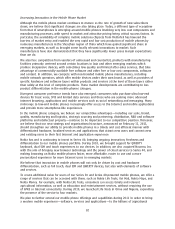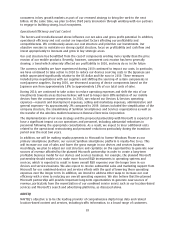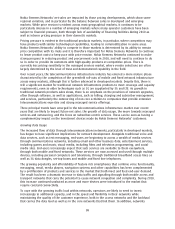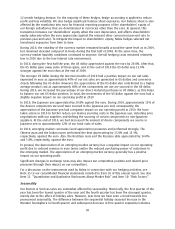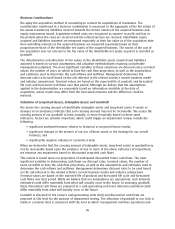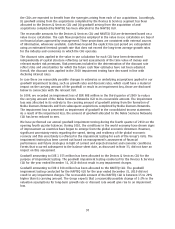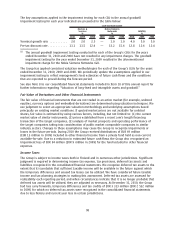Nokia 2010 Annual Report Download - page 93
Download and view the complete annual report
Please find page 93 of the 2010 Nokia annual report below. You can navigate through the pages in the report by either clicking on the pages listed below, or by using the keyword search tool below to find specific information within the annual report.Nokia Siemens Networks planned acquisition of certain wireless network infrastructure assets
of Motorola
On July 19, 2010, Nokia Siemens Networks announced that it had entered into an agreement to
acquire the majority of Motorola’s wireless network infrastructure assets for USD 1.2 billion in cash
and cash equivalents. Approximately 7 500 employees are expected to transfer to Nokia Siemens
Networks from Motorola’s wireless network infrastructure business when the transaction closes,
including large research and development sites in the United States, China and India. As part of the
transaction, Nokia Siemens Networks expects to enhance its capabilities in key wireless technologies,
including WiMAX and CDMA, and to strengthen its market position in key geographic markets, in
particular Japan and the United States. Nokia Siemens Networks is also targeting to gain incumbent
relationship with more than 50 operators and to strengthen its relationship with certain of the
largest communication service providers globally.
The Motorola acquisition is expected to close after the final antitrust approval by the Chinese
regulatory authorities has been granted and the other closing conditions have been met.
Critical Accounting Policies
Our accounting policies affecting our financial condition and results of operations are more fully
described in Note 1 to our consolidated financial statements included in Item 18 of this annual
report. Certain of our accounting policies require the application of judgment by management in
selecting appropriate assumptions for calculating financial estimates, which inherently contain some
degree of uncertainty. Management bases its estimates on historical experience and various other
assumptions that are believed to be reasonable under the circumstances, the results of which form
the basis for making judgments about the reported carrying values of assets and liabilities and the
reported amounts of revenues and expenses that may not be readily apparent from other sources.
Actual results may differ from these estimates under different assumptions or conditions. The
estimates affect all our segments equally unless otherwise indicated.
We believe the following are the critical accounting policies and related judgments and estimates
used in the preparation of our consolidated financial statements. We have discussed the application
of these critical accounting estimates with our Board of Directors and Audit Committee.
Revenue Recognition
Sales from the majority of the Group are recognized when the significant risks and rewards of
ownership have transferred to the buyer, continuing managerial involvement usually associated with
ownership and effective control have ceased, the amount of revenue can be measured reliably, it is
probable that economic benefits associated with the transaction will flow to the Group, and the costs
incurred or to be incurred in respect of the transaction can be measured reliably. The remainder of
revenue is recorded under the percentage of completion method.
Devices & Services and certain NAVTEQ and Nokia Siemens Networks revenues are generally
recognized when the significant risks and rewards of ownership have transferred to the buyer,
continuing managerial involvement usually associated with ownership and effective control have
ceased, the amount of revenue can be measured reliably, it is probable that economic benefits
associated with the transaction will flow to the Group and the costs incurred or to be incurred in
respect of the transaction can be measured reliably. This requires us to assess at the point of delivery
whether these criteria have been met. When management determines that such criteria have been
met, revenue is recognized. We record estimated reductions to revenue for special pricing
agreements, price protection and other volume based discounts at the time of sale, mainly in the
mobile device business. Sales adjustments for volume based discount programs are estimated based
largely on historical activity under similar programs. Price protection adjustments are based on
estimates of future price reductions and certain agreed customer inventories at the date of the price
92


